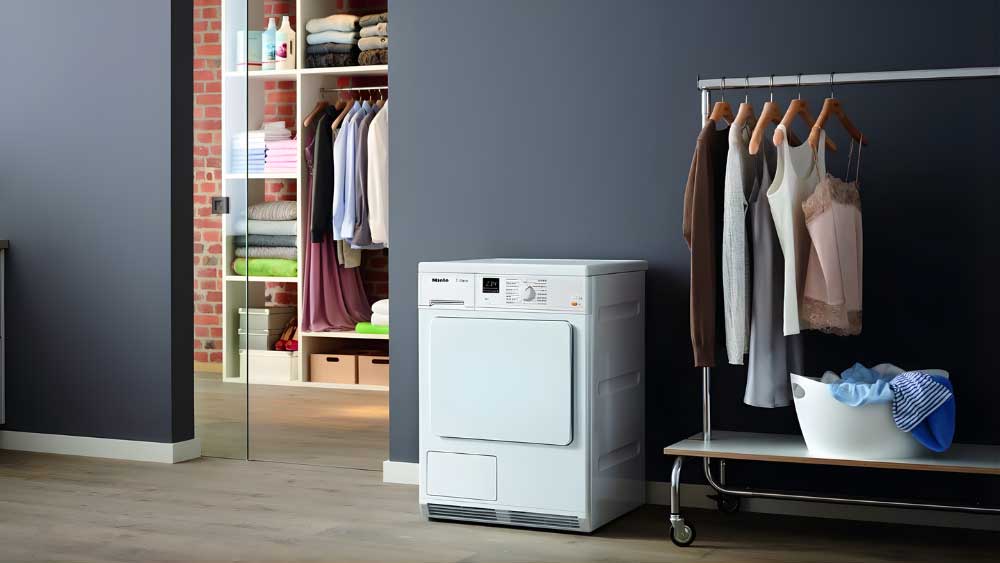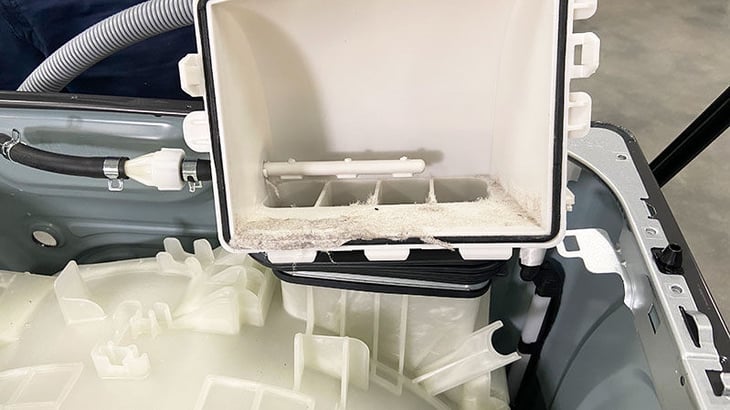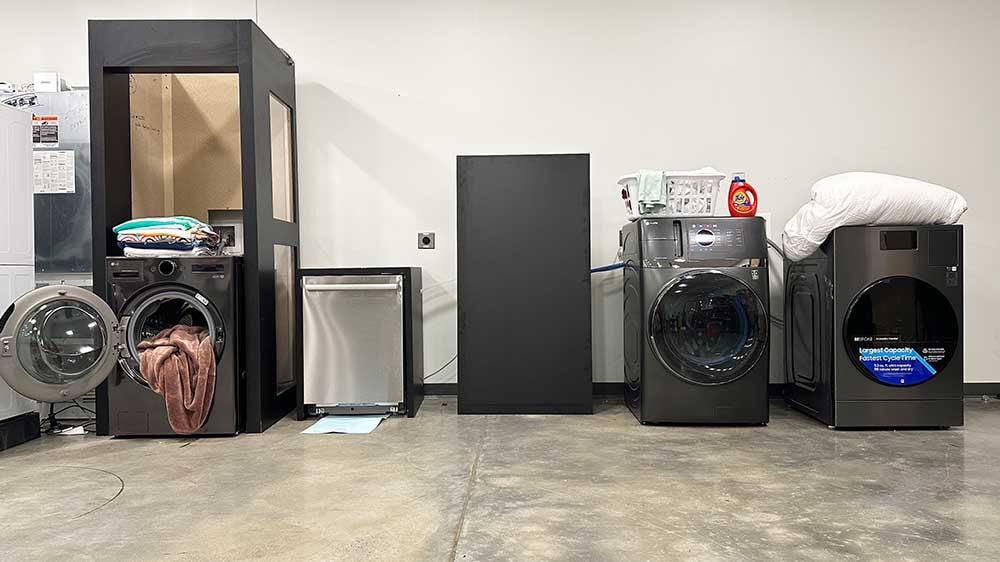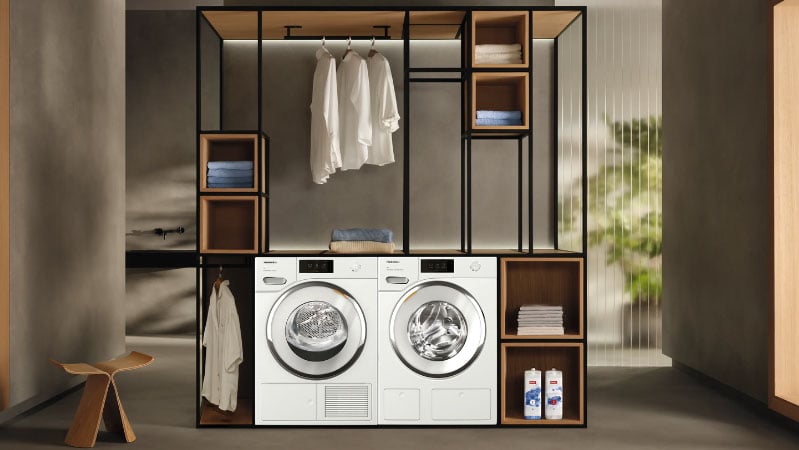Vented vs Condenser vs Heat Pump Dryers (2025): Real Costs, Pros & Trade-Offs
November 7th, 2025 | 8 min. read

TL;DR: Quick Answer
- Verdict: Choose a heat-pump dryer for lower bills and gentler drying. Pick vented for the fastest cycles if you already have a clean exterior vent. Skip condenser models.p>
- Costs: About a $650 higher upfront for heat pump vs vented, roughly 50% energy savings, about $175 per year saved at $0.28/kWh.
- Combos: One-step, space-saving, and reliable in year one with regular filter cleaning. Slower overall.
- Before you buy: Confirm local service for heat-pump systems and plan basic maintenance (lint every load, condenser/heat-pump filter monthly, vent cleaning for vented).
You probably didn’t know your dryer uses more energy than any appliance in your home, except your HVAC system.
In Massachusetts, that matters a lot. We pay some of the highest electricity rates in the country, about 28¢ per kilowatt-hour.
That makes your choice of dryer more than just a matter of convenience; it’s a financial decision.
Over the past decade, heat-pump dryers have been marketed as the energy savers of the future.
They’re far more efficient than traditional vented or condenser dryers. But as with any new technology, there are trade-offs you should know about before buying one.
In this article, we’ll look at the three main types of dryers: condenser, vented, and heat pump, plus the new combination models.
You’ll learn how they actually work, what they cost to run, and which makes the most sense for your home and family.
Let’s get started.
📽️ Prefer a Video?
In this video, you’ll learn how vented, condenser, and heat-pump dryers work, what they cost to run, and the key trade-offs.
📌 Skip Ahead:
- When Were Heat Pumps Invented?
- Condenser Dryers
- Vented Dryers
- Heat Pump Dryers
- Combination Heat Pump Dryers
- What to Buy
- Key Takeaways
- FAQs
Pop Quiz: When Were Heat Pumps Invented?
When do you think the first heat pump was invented?
- 1850s
- 1930s
- 1990s
- 2003
They go way back, all the way to the 1850s in Austria, where heat pumps were used to dry out salt marshes near Vienna.
It took another century before the same idea powered heating systems and, later, home dryers.
📝 Odd note: Electrolux was the first to manufacture a heat-pump dryer; however, they still haven’t marketed it in the U.S. as of this writing.
Condenser Dryers: The First Ventless Option (Now Mostly History)

Condenser dryers had their moment in the 1990s and early 2000s, before heat-pump technology took over.
They were especially popular in apartments and condo buildings where cutting an exterior vent was expensive or restricted by building codes.
Ventless designs also helped some projects qualify for LEED Silver or Gold certifications, since venting outdoors can lower a building’s energy-efficiency rating.
I had an old Miele condenser dryer in my laundry room years ago.
It would get really hot, great in winter, but miserable in summer.
That’s because condenser dryers do not reuse heat, they release it straight back into the room.
This was the first true ventless solution, but the technology was simple.
Instead of recycling air like a heat pump, a condenser dryer uses the same electric heating elements that have been around for decades.
 Warm air passes through a condenser coil that removes moisture from the clothes, and that water either drains with your washer waste line or collects in a small tank you empty manually.
Warm air passes through a condenser coil that removes moisture from the clothes, and that water either drains with your washer waste line or collects in a small tank you empty manually.
It’s a clever workaround, but not an efficient one.
Because it does not reuse heat, a condenser dryer warms and humidifies your laundry room, which can force your HVAC to work harder in summer.
It may offset heating costs in winter, but that is not how you want to manage utility bills.
People still ask for “ventless dryers,” but what they usually mean today are heat-pump dryers.
We share this to avoid confusion with outdated marketing.
Condenser dryers are old technology, and none of the brands we carry offer them anymore.
So if you see a “ventless dryer” online under $1,000, it is likely a condenser.
Do not be fooled by the label.
Miele was the most popular condenser dryer at one time and was first to market exclusively with heat-pump models in 2018.
Condenser Dryer Pros
✔️ Ventless installation, no duct or wall vent needed
✔️ Simple, reliable technology
✔️ Can contribute to certain LEED energy certifications
✔️ Adds warmth to the room in winter
Condenser Dryer Cons
❌ Least efficient of all dryer types
❌ Heats up your laundry space in summer
❌ Slower drying times
❌ Rarely sold today, replaced by heat-pump models
Vented Dryers: The Reliable Workhorse That’s Still in Most Homes

Vented dryers have been around forever. My grandfather was selling them 80 years ago, and I still have one in my own home.
When I moved in back in 2017, I didn’t want the smaller condenser models, and larger heat pumps weren’t available yet.
Vented dryers are simple, reliable, and easy to fix, which is why they still make up the majority of dryers sold today.
A vented dryer pulls air from your room, heats it with electric or gas elements, and then vents that hot, moist air outside.

It is simple, essentially a large hair dryer blowing heated air through your clothes and out the duct.
The result is fast, effective drying, but at a cost.
Because all that heat is expelled outdoors, vented dryers are the least energy-efficient of the modern options.
You are constantly heating new air instead of recycling it, and that adds up, especially in Massachusetts, where electricity costs about 28¢ per kilowatt-hour.
Most people don’t think about vent cleaning, but lint can build up inside the duct.

That buildup can occasionally cause a dryer fire, but more often it wastes energy and adds minutes, even hours, to each cycle.
A clogged vent makes your dryer work harder than it should, shortening its lifespan and quietly driving up utility costs.
Vented Dryer Pros
✔️ Proven, reliable design; easy to service
✔️Dries clothes quickly
✔️Low upfront cost
✔️Compatible with existing ductwork
Vented Dryer Cons
❌ Least efficient type overall
❌Requires external venting and regular duct cleaning
❌Loses heated air from your home
❌Not ideal for small spaces or condos
Heat Pump Dryers: Efficient, Gentle, and Finally Ready for Prime Time

Heat pump dryers have come a long way.
Five years ago, most were compact European models—great for condos but too small for a family of four.
Now you can buy full-size or compact heat-pump dryers up to 7.3 cubic feet in capacity.
The most popular brands are LG, GE Profile, Samsung, Miele, and Whirlpool.
Heat pumps come in both 110-volt and 220-volt versions, depending on the model and installation needs.
They have moved from niche to mainstream, and for good reason.
Pricing and Energy Overview
| Typical Price Range | Average Cost (2025) | |
| Vented Dryer | $749–$1,199 | ≈ $949 |
| Heat Pump Dryer (Standard) | $1,399–$2,199 | ≈ $1,799 |
| Combo Heat Pump Washer-Dryer | $2,199–$2,999 | ≈ $2,499 |
That’s roughly a $650 difference between a vented and a heat-pump dryer, or about three to five years of energy savings in Massachusetts.
How a Heat Pump Dryer Works
A heat-pump dryer is essentially a refrigeration system in reverse.
It uses a compressor and refrigerant to capture, condense, and recycle warm air instead of venting it outside.
 Warm air absorbs moisture from your clothes, passes through an evaporator coil where that moisture condenses into water (drained or collected in a tank), then reheats and circulates again.
Warm air absorbs moisture from your clothes, passes through an evaporator coil where that moisture condenses into water (drained or collected in a tank), then reheats and circulates again.
It is a closed loop with no wasted air, no vent, and far less energy loss.
Energy Efficiency (Real Numbers)
| Avg. Energy Use Per Load | Cost per Load | Annual Cost (1 Load/Dry) | |
| Standard Electric | 3.4 kWh | $0.95 | ≈ $350/year |
| Heat Pump (50% savings) | 1.7 kWh | $0.48 | ≈ $175/year |
Even for a small household, that is about $175 saved per year, and much more for a larger family.
And because the air is recycled instead of exhausted outside, you are not wasting conditioned air from your home.
The Best Heat Pump Dryers for 2025
| Model | Voltage | Capacity | Approx. Price | Highlights | |
| Miele TXD 160 WP | Compact 24" design with fragrance dispenser and auto-sense drying | 110 V | 4.0 cu ft | $1,799 | Ideal for apartments and secondary laundry rooms |
| LG DLHC5502B | Full-size 7.3 cu ft with TurboSteam and AI Sensor Dry | 220 V | 7.3 cu ft | $1,549 | Large capacity, quiet, and energy efficient |
| GE Profile UltraFast Combo | Washer + Heat Pump Dryer in one unit | 110 V | 4.8 cu ft | $2,499 | Wash and dry in one cycle; 32-load dispenser & Microban surfaces |
| LG WashTower with Heat Pump | Space-saving stacked design with central controls | 220 V | 7.2 cu ft | $2,699 | Great for families, efficient, and easy to use |
| Whirlpool WHD560CHW | New full-size 7.4 cu ft design for 2025 | 220 V | 7.4 cu ft | $1,599 | Energy Star Most Efficient with moisture sensors |
🔍 Read more: The Best Heat Pump Dryers
Heat Pump Dryer Reliability and Service

From our service data across Miele, Bosch, and LG, heat-pump dryers have proven extremely reliable, with first-year service rates averaging 5-8%—among the lowest in the laundry category.
LG’s heat-pump dryers and WashTowers were particularly strong, averaging around 8.1% in the first year, just below the appliance average of 9.%.
Most issues are minor, such as clogged filters or blocked condensers that trigger error codes.
The real challenge isn’t reliability; it’s service availability.
Heat-pump dryers are still newer technology, and not every service company knows how to diagnose or repair the sealed system inside.
🔍 Read more: Are Heat Pump Dryers Reliable?
Combination Heat Pump Dryers: Convenience Meets Commitment

Combination heat-pump washer-dryers are the latest evolution in laundry, and they are getting better every year.
Brands like GE Profile, LG, and Samsung now offer combo models that wash and dry in the same drum, with no transfer between machines.

The biggest advantage is convenience.
You can throw in a dirty load before bed and by morning it is clean, dry, and ready to wear.
Or start a load before leaving for work and come home to finished laundry—no more forgetting damp clothes in the washer all day.
That single-step design also saves space, with no need for separate washer and dryer hookups.

And because they use heat-pump technology, these combos are ventless, energy-efficient, and run on standard 110-volt power, so they can fit almost anywhere.
Reliability: Surprisingly Strong

Despite the newer technology, combination heat-pump units have proven reliable in their first year.
In our 2024 service data, the GE Profile UltraFast Combo had about a 9.5% first year service rate and LG’s was about 8.5%, both close to the 9% category average.
The takeaway: reliability isn’t the issue.
The real variable is maintenance—especially filter cleaning. Keep it up, and these machines should last as long as a conventional setup.
| First-Year Service Rate | |
| LG WashCombo | 8.5% |
| GE UltraFast | 9.5% |
| Appliance Average (all categories) | 9% |
Source: Yale Appliance service data, 33,000+ service calls (2024).
🔍 Read more: Are Combo Washers and Dryers Reliable?
Conclusion: What to Buy — and Why

If you already have a good exterior vent and want speed and simplicity, a vented dryer still makes sense.
Just clean the duct; a clogged vent wastes energy and adds minutes, even hours, to every cycle.
If you need ventless, skip condenser dryers.
They are older technology, heat up your room, and cost more to run.
If you care about lower bills, gentler drying, and flexible placement, choose a heat pump.
Today’s models are larger (up to 7.3 cu. ft.), available in 110-volt and 220-volt versions, and far more capable than even a few years ago.
The trade-off is time, and making sure someone can actually service what you buy.
If you want one-and-done convenience in a tight space, combo heat-pump units are better than most people expect.
They are slower, but our data shows excellent first-year reliability, even better than many standalone washers, as long as you clean the filters.
Key Takeaways
- Vented: Fast, reliable, and inexpensive; least efficient. Clean the duct.
- Condenser: Ventless but inefficient and hot; mostly phased out.
- Heat Pump: Most efficient and gentlest on fabrics; longer cycles. Check service availability.
- Combos: True one-step laundry; slower but surprisingly reliable if maintained.
FAQs
Answers to the most commonly asked questions about vented, condenser, and heat pump dryers.
🚫 Do heat-pump dryers need to be vented?
No. They are fully ventless. The air is recycled through the heat-pump system, so you do not need an external duct.
⏱️ Do heat-pump dryers take longer to dry?
Yes. Expect 15 to 40 minutes longer per load, but the trade-off is up to 60% energy savings and gentler drying.
🛡️ How reliable are LG heat-pump dryers?
In Yale’s 2025 service data, LG’s heat-pump dryers and WashTowers averaged 4.5% service in the first year, making them among the most reliable dryers sold.
🧽 How often should I clean a heat-pump dryer filter?
Clean the lint filter after every cycle and the condenser filter monthly to maintain efficiency and prevent clogging.
🔄 How reliable are combo washer-dryers?
In our 2025 service data, the GE Profile UltraFast Combo had a 5.2% first-year service rate, lower than standard washers. This proves the technology is sound when filters are maintained.
Additional Resources
Download our Yale Washer & Dryer Buying Guide with all the features, terms, and brands of laundry. Over 1.5 million people have already found answers in a Yale guide.
Related Articles:
Why Should You Trust Us?
It seems that every appliance review has nothing but glowing comments about almost every product, yet you read customer reviews and they are almost universally bad.
We are here to fill in the disconnect. We'll give you the best features, and the drawbacks as well, including reliability based on over 37,000 calls performed by our service team just last year. Our goal is to give you ALL the information so you know what's right for you.
Please consider subscribing or adding to the conversation in the comments below. We appreciate you stopping by.
Steve Sheinkopf is the third-generation CEO of Yale Appliance and a lifelong Bostonian. He has over 38 years of experience in the appliance industry, and he is a trusted source of information for consumers on how to buy and repair appliances.
Steve has also been featured in numerous publications, including the
New York Times,
Consumer Reports,
The Boston Globe,
Bloomberg Radio, the
New York Post,
The Wall Street Journal, and
Entrepreneur, for his knowledge of how to buy appliances and appliance repair.
Steve is passionate about helping consumers find the best appliances for their needs, and he is always happy to answer questions and provide advice. He is a valuable resource for consumers who are looking for information on appliance buying, repair, and maintenance.
Despite being the worst goalie in history, Steve is a fan of the Bruins and college hockey, loves to read, and is a Peloton biker. The love of his life is his daughter, Sophie.
A Note About Pricing
Pricing on this blog is for reference only and may include time sensitive rebates. We make every attempt to provide accurate pricing at time of publishing. Please call the stores for most accurate price.
Topics:



